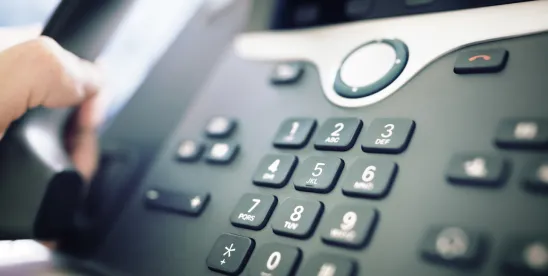Businesses may dial large volumes of numbers daily for a variety of legitimate purposes. These calls now appear to have become swept up and conflated with illegal robocalls, with a number of undesirable consequences. Certainly policy makers at the FCC, in reacting to understandable concerns about fraudulent and illegal calling, have been introducing more and more opportunities for voice service and app providers to apply non-transparent, subjective standards to block calls, and further muddy the water for business callers.
“Call Blocking by Default” is the most recent rule that the FCC is contemplating adopting. The FCC has unanimously adopted over a dozen measures related to robocalls and caller ID spoofing since January 2017. The FCC issued a draft Declaratory Ruling and Third Further Notice of Proposed Rulemaking (“FNPRM”) on May 16, 2019, as an agenda item for its upcoming June 2019 open meeting. This set of proposed rules would “give voice service providers the legal certainty they need to block unwanted calls from the outset so that consumers never have to get them,” said Chairman Ajit Pai in a press release on May 15, 2019. The phrase “unwanted calls” appears twenty-six (26) times in the body text of this draft FNPRM. By extending call-blocking services beyond illegal calls to an entirely subjective “unwanted” call category, and by promoting such call-blocking services by default, the FCC is taking an increasingly aggressive (or, some may argue, overreaching) stance.
According to the draft FNPRM, the FCC receives “hundreds of thousands of complaints from consumers about unwanted calls” every year. The FCC uses this aggregated data as a guide to develop “policy and enforcement” and also makes it “available for third parties to improve call blocking and filtering tools.” Without defining “unwanted calls” in this draft FNPRM, the FCC considers unwanted calls to include robocalls, telemarketing calls, and calls made to numbers reassigned to a new subscriber (now covered by the not-yet-existing single, centralized reassigned numbers database, which we previously discussed here). In fact, the FCC acknowledges that some of those complaints are “about calls that are lawful, but are simply unwanted.”
Available data cited in this FNPRM hardly is an accurate reflection of the illegal robocall problem that the FCC has the legal authority to address. However, the FCC acknowledges that many commercial data sources “do not generally differentiate between legal and illegal calls, wanted and unwanted.” One example is app providers YouMail categorizing “spam calls” and “debt collection calls” almost interchangeably, oblivious to the important business and consumer protection function that legal debt collection calls may serve.
Prior to January 2017, the FCC permitted network-based blocking only in “specific, well-defined circumstances” and reserved the choice to individual end users if they would like to block unwanted calls from certain numbers. By definition, “unwanted” is a subjective judgment and who makes that determination is critical. Even recently, in the November 2017 Call Blocking Order, the FCC interpreted “specific, well-defined circumstances” as when the calls “are highly likely to be illegitimate because there is no lawful reason to spoof certain kinds of numbers.”
The draft FNPRM opens a new and potentially troubling front, and the agency, if it ultimately adopts this approach, seems to be open to rejecting the need for any standard, objective, or reasonable review as to whether blocking a type of call without consumer consent would fall under the “specific, well-defined circumstances.” The FCC’s proposed “Call Blocking by Default” regime would encompass all “illegal calls, calls blocked with consumer choice, or calls for which the Commission has authorized blocking.” As a practical matter, how can any business make sure none of its calls are “unwanted”? Highly skilled prospecting or extraordinary customer relationship skills may just be a start to staying ahead in (or rather, staying out of) this popularity contest.
The FCC’s statutory authority to self-authorize these broad categories of network-based blocking is also up for debate. Indeed, the FCC asked in the draft FNPRM: “Does our authority depend, in part or at all, on whether the calls considered in a call-blocking program are in fact illegal under federal law or merely unwanted by consumers?”
Despite inaccuracy in supporting statistics and questionable legal authority to proceed, the FCC blames “unwanted wireline and wireless calls” for reducing the value of telephone communications. Ironically, the opt-in rates for call blocking technologies are currently low. “As Consumers Union puts it, ‘so few consumers opt-in to robocall blocking tools, yet continually express their frustration with the unending barrage of nuisance calls,’” the draft FNPRM highlights.
So, what does the FCC have in mind for “unwanted calls”?
As drafted, the FNPRM would allow voice service providers to “offer opt-out call-blocking programs based on any reasonable analytics designed to identify unwanted calls.” Such “reasonable analytics” could render their judgment based on one or more of many factors, including large bursts of calls in a short timeframe, common Caller ID Name (CNAM) values across voice service providers, a large volume of complaints related to a suspect line, and whether the calling number has appropriately signed calls under the SHAKEN/STIR framework.
“White-list programs” is another feature of this draft FNPRM. These type of programs offer to “block all calls to a customer except from a customer-defined list of telephone numbers” such as numbers uploaded from the contact list in the customer’s own phone. The FNPRM describes these programs as “an added level of protection from unwanted calls and the frustrations that go with them.” It is not at all clear how practical these programs would be, considering the large number of individuals and entities with whom businesses and customers transact without ever saving each one of their phone numbers in their contact lists.
On the issue of establishing a safe harbor for voice service providers, the FCC is also considering among a spectrum of approaches – from wide-ranging sweeping exemption that encourages providers to block any “potentially spoofed calls” to a more restrained exemption that would only apply to voice service providers that have demonstrated history of facilitating unlawful robocalls.
Erroneous blocking is still the top area of concern, just not for the FCC
This draft FNPRM seemingly spares little thought – a total of one and a half paragraph – to “encourage[] voice service providers” to establish a means for a caller whose calls are blocked in error to challenge and remedy this problem. Since issuing the 2017 Call Blocking Order, the FCC has taken the stance just last year that inadvertent or erroneous call blocking and text blocking are too rare an instance and easily resolved on the provider-level. The FTC in comments to the FCC supported this position, stating: “[I]t appears unlikely that there will be a significant risk of erroneous blocking arising from providers taking advantage of the authority granted by the [2017 Call Blocking Order],” which is “limited in scope” and “should be relatively small and easy to verify and correct.”
The draft FNPRM seems to suggest that the FCC may not impose any specific regulatory requirements or mechanism to remedy inadvertently or mistakenly blocked calls at all. After several proceedings and requests for comments, the FCC seemingly is still not convinced that regulatory requirements or remedial mechanisms for erroneous blocking are necessary and would be effective. This draft FNPRM asks: “Is such a mechanism necessary?” “How significantly would [the protection from erroneous blocking] reduce erroneous blocking, or allow such blocking to be corrected more quickly?”
But for most legitimate businesses that conduct high-volume business-to-consumer (B2C) calls, this is the issue of utmost importance. For some, their businesses’ livelihood depends on it. Since the 2017 Call Blocking Order, legitimate calls are being blocked or labeled in error due to the inaccuracy and inconsistency among call-blocking and spam-tagging technologies employed by different service providers. According to one of a series of Microsoft filings in December 2018, when carriers began employing a variety of factors on their own to determine which calls to block, legitimate callers using unconventional calling technologies were severely affected. For example, some carriers used callback capability as a method to verify the authenticity of an initiating phone number. They unintentionally blocked over 1.2 million legitimate Skype outbound-only calls during a three-month period because those originating phone numbers did not have the ability to receive inbound calls.
Blurring the line between legitimate and illegal robocalls endangers our market-based society, commented Commissioner Michael O’Rielly on the same day: “Unfortunately, despite your organization’s substantial and justified win in [ACA International v. FCC], the ‘fog of uncertainty,’ as the D.C. Circuit put it, remains thicker than ever.” His speech addressed to the audience at the Washington Insights Conference hosted by ACA International, a trade group who successfully pushed the D.C. Circuit in 2018 to strike down the broad definition of audodialer under the TCPA.
Currently, many businesses may be unaware of when and which service providers or apps have blocked their number or tagged their number as spam; even if they become aware of the call blocking or the spam tagging on their number, they have to follow each service provider’s or app provider’s individual processes to seek to extricate heir number from the call blocking or spam tagging database. The total lack of transparency and reasonable process can be especially costly and challenging for businesses that use large pools of phone numbers.
The FCC appears to be trying to be responsive to the popular sentiments against calling, reflected in recent congressional hearing on seven robocall bills on April 30, 2019 (which we previously discussed here). However, the agency predictably may run into significant legal difficulty by embarking on a path that may result in critically important calls being blocked because a third party (app or service provider) has applied an algorithm or subjective process to determine for an end user that a call is “unwanted.”




 />i
/>i

